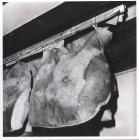Everything except the squeal
Items in this story:
The ultimate in recycling
You can use every bit of a pig except its squeal. Pigs were an important part of the home economy, nothing was wasted.
Pigs were once an important part of everyday rural and urban life. They were the ultimate in recycling, converting waste into a useful product. They produced large litters and fattened quickly, eating anything from grass to scraps and leftovers. Killing a pig was a social occasion and friends and neighbours would often take it in turns to slaughter their pigs and share the meat.
Share and share alike
Slaughtering would usually be carried out between early October and late March, thus providing families with a regular supply of fresh meat throughout the winter. Pork steaks and joints incorporating the ribs and back chain were the usual cuts shared among the community. Dishes prepared from the pig's offal (e.g. faggots and brawn) were also bonus gifts exchanged between friends and relatives, and this custom was practised in parts of south Wales well into the second half of the 20th century. The pleasant task of delivering the cuts of meat was generally allocated to the children, who would be given some money for their trouble. In some districts, this custom was known as hebrwng asgwrn (sending a bone). The remainder of the pig would be salted, and would serve as the main source of meat for the household throughout the year.
Nothing Wasted
Nothing was wasted. The pig's head would be boiled to make brawn. The pig's bristles could be used for brushes, its skin for making leather, blood for black pudding, and even its bladder for a football. It's no wonder that so many people kept pigs. Some even say that the ‘piggy bank' acquired its name because it was fed the leftovers of people's small change until it was fat enough to be smashed, and the savings retrieved.
Liver and Onions: Mrs Edith May Hughes
"Then there was the liver. Mam had a big iron pan on the hob. And she'd cook the liver very slowly. She always had flour to hand, and a board. Then when she went to cut up the liver, there'd be flour on the board, and the liver would be put in it. She'd slice it, and dip it in the flour before frying it. The the onions would be fried, with the liver, slowly. There'd be a panful, by the time the liver was ready. She'd take the liver out, and make a pan full of good gravy with all these onions. The liver would be put in with it and would keep nice and tender, and hot. By the time we came home from school in the evening, you see."
Mrs Edith May Hughes, Llannerch-y-medd, Ynys Môn. Born 1904. (SFNHM recording 3977/1)
Liver, Bacon and Onions
This particular dish was popular as swper chwarel (the evening meal after returning home from the quarry) in the slate quarrying districts of north Wales.
half a pound bacon rashers one pound liver onions salt and pepper a little plain flour Slice the liver and toss in seasoned flour. Fry the bacon rashers lightly and lift out on to a warm dish. Make gravy by mixing a tablespoonful of plain flour into the fat in the pan, adding a little boiling water and stir well. Boil for a few minutes. Fry the liver and chopped onion in the bacon fat and then place with the bacon. Serve this dish with boiled potatoes.
Collected in Lleyn, Caernarvonshire.


